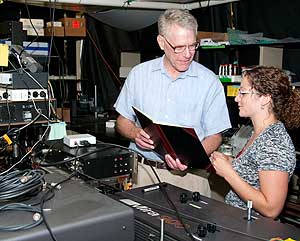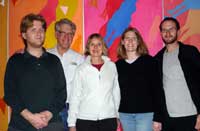Sometimes a prediction is so off the mark it’s comical — take one made by Elliot L. Elson, Ph.D., early in his career.

He had teamed up with physicists Watt W. Webb, Sc.D., and Douglas Magde, Ph.D., to study how DNA double helices unwind. For many months, they struggled without success. But ultimately their efforts led to a new way of detecting molecular motion.
Their technique was so original Webb suggested they patent it. Elson replied, “Watt, this is the most elegant thing we will ever have worked on, but it’s also the most useless.”
Now, more than 35 years later, the method — fluorescence correlation spectroscopy (FCS) — has advanced into a sophisticated and widely adopted technology.
“I was wrong about FCS,” Elson says with a chuckle. “Now several companies produce commercial FCS instruments, and it’s used in labs around the world.”
Elson, the Alumni Endowed Professor of Biochemistry and Molecular Biophysics, joined the School of Medicine in 1979, and here he has studied the movement and distribution of cell surface proteins, cell motility and the forces that determine the shapes of cells.
“Elliot is the consummate scientist, using experimental observation and intellectual curiosity as his compass in the laboratory instead of popular dogma,” says Tom Ellenberger, D.V.M., Ph.D., the Wittcoff Professor and head of the Department of Biochemistry and Molecular Biophysics.
“For many years, Elliot has focused on understanding how cells and tissues are organized as physical entities,” Ellenberger says. “One could say that he is an old-school nanomaterials scientist, drawing insights from biology that can be constructed into a set of engineering principles for life itself.”
Getting into science
Elson grew up in St. Louis and earned a bachelor’s degree in biochemistry from Harvard University. He thought he was headed for a career in medicine. His father, a cardiologist, hoped his son would follow in his footsteps.

“I had huge stacks of medical school applications on my desk,” Elson says. “But I realized I really wanted to do scientific research. So somewhat to my father’s dismay, I didn’t go to medical school.”
Elson’s undergraduate adviser, renowned biochemist John T. Edsall, Ph.D., said that for his graduate work, Elson should apply to Arthur Kornberg, M.D., head of microbiology at Washington University.
Elson went to see the eminent scientist, meeting him in his lab in the West Building. Kornberg was in the midst of an experiment and continued pipetting samples while he interviewed Elson.
Even with such distractions, the exchange went well, and Elson was accepted into the department. It was 1959, the year Kornberg won a Nobel Prize in Physiology or Medicine for his work on DNA biochemistry.
It was also the year Kornberg moved to Stanford University to head the biochemistry department. Elson went, too, and there he got a less-than-glamorous initiation into cutting-edge science.
“My first job was unpacking the boxes they had moved from St. Louis,” Elson says.
Advancing on FCS
At Stanford, Elson delved into the physical chemistry of DNA. James Watson, Ph.D., and Francis Crick, Ph.D., had only recently proposed the double-helical structure of DNA, and biochemists were eagerly analyzing how the molecule behaved in living cells.
The DNA helix has to unwind so that genes can be decoded. Elson worked out a theory for DNA unwinding while a postdoctoral associate at the University of California, San Diego.
Finishing his postdoctoral stint, Elson moved to Cornell University as assistant professor of chemistry in 1968. There he decided to test his theory by looking at the double helix in a state in which short sections spontaneously twist and untwist. That led to the development of FCS.
“With FCS, you pass a narrow laser beam through a mixture that contains a few fluorescent molecules,” Elson says. Elson made use of fluorescent molecules that could enter the DNA double helix when the bonds between strands loosened.
“When a molecule enters the beam, it fluoresces, or emits a burst of light, which you can use to determine how fast molecules diffuse under specific conditions,” he says. “The great advantage of FCS is that you can apply it in very tiny systems, including living cells.”
Elson and his colleagues never solved how to measure DNA unwinding, but FCS took on a life independent of the question it was designed to answer.
Pattern of invention
In his lab, Elson and his lab members construct many of the instruments they use, which are often assembled from recycled components.
“They build what they need from scratch, even to the point of using things they’ve salvaged from a Dumpster,” says frequent collaborator Guy Genin, Ph.D., associate professor of mechanical, aerospace and structural engineering, pointing out that a soda can was used to make the universal joint for one instrument.
|
Elliot L. Elson |
|
Education: B.S., biochemistry, Harvard University; Ph.D., biochemistry, Stanford University Titles: The Alumni Endowed Professor of Biochemistry and Molecular Biophysics, professor of physics in Arts & Sciences and of biomedical engineering Family: Wife, Frances Tietov, who is principal harp at the Saint Louis Symphony Orchestra; sons Louis Woodhams, 30, a graduate of the University of Miami in philosophy, and Julian Elson, 25, a graduate of the University of Chicago in economics. Both sons live in Books: Co-author with Hong Qian, Ph.D., of the University of Washington, of an upcoming book “Introduction to Fluorescence Correlation Spectroscopy” |
“The lab is one of the first places we show engineering-school visitors, and it’s always a highlight. The Elson lab members perform experiments no one else can do,” Genin says.
A pattern of posing a scientific question and then working with colleagues to design a tool to help answer it continues to mark Elson’s career. To measure diffusion of molecules on cell surfaces, he and colleagues developed FRAP (fluorescence recovery after photobleaching), a sister technology of FCS.
To gauge the elasticity of individual cells, they built their own cell indenter. The instrument holds a tiny probe that taps cells and measures resistance — like a baker judging the springiness of dough by poking it with a finger.
To determine the contraction of cells, such as those that restore tissue integrity during wound healing, Elson’s team put together an apparatus whose hooks and bars sense the tension from a band of artificial tissue.
They also invented the method for making the tissue. They suspend living cells in a Jell-O-like matrix of collagen, which is molded into a cylinder and soaked in a warm nutrient bath.
This type of tissue engineering has been used to create artificial heart tissue in which the cells learn to contract in unison, beating like a bit of natural heart muscle. Other labs are testing such tissue to see if it could help restore heart function after a heart attack.
“Simply put, Elliot is brilliant,” says Carl Frieden, Ph.D., professor of biochemistry and molecular biophysics. “It has been a privilege to have my lab next to his and to be able to call on his expertise at any time. Internationally known and respected, his approach to science puts him well ahead of the curve.”
The ingenuity of his co-workers is responsible for many of the inventions in his lab, Elson says. Current members include Tony Pryse, Ph.D., senior scientist, and William McConnaughey, staff scientist, who created the cell indenter.
Genin says that Elson maintains an open-door policy that benefits many at the University.
“Nearly every person in the engineering school who is doing biophysical research uses his equipment,” Genin says. “Our late colleague George Zahalak remarked to me that Elliot is the perfect collaborator: He has the patience to listen, the intellect to understand, the fluency to explain, and the warmth of personality to make learning a joy.”
Rafting on
Elson’s most recent research focuses on theoretical structures called lipid rafts. Some scientists have proposed that the outer surface of cells contains islands, or “rafts,” of tightly packed lipid molecules floating in a sea of fluid lipids. But no one is sure whether rafts are real, and if so, whether they are persistent or fleeting. Elson is trying to resolve that issue with methods such as FCS.
The work could reveal how lipid rafts might regulate the growth of malignant tissues such as breast tumors. It could also help scientists understand what happens when viruses like HIV reproduce and burst from their host cells, taking snippets of cell membrane with them.
Juggling his numerous projects and collaborations, Elson retains his great enthusiasm for scientific investigation and for the new ideas and technologies that have entered the field of biochemistry over the years. He looks forward to what’s next on the horizon: “It’s a given,” he says, “you’ll never run out of things to discover.”